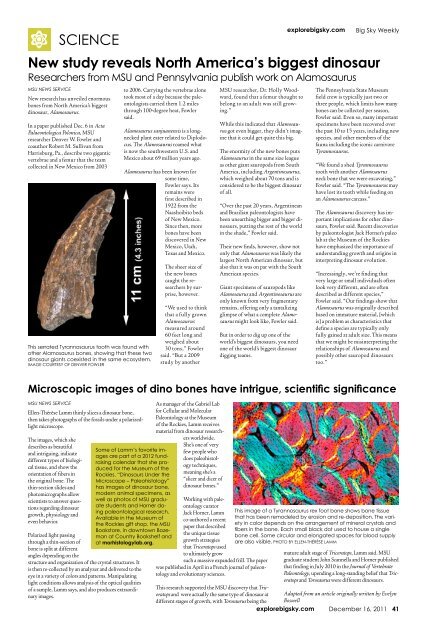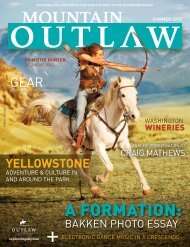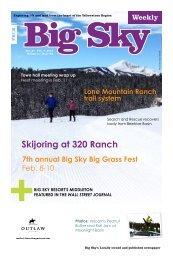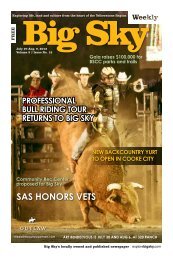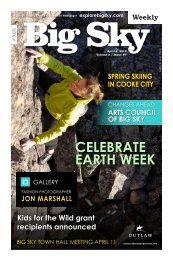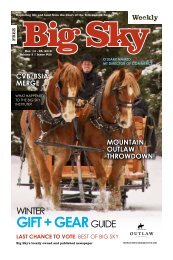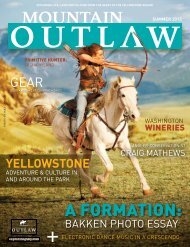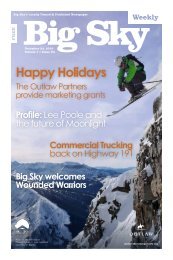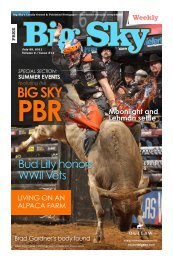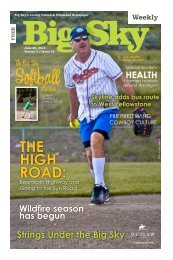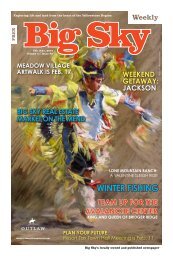New Year's Eve Bash - Explore Big Sky
New Year's Eve Bash - Explore Big Sky
New Year's Eve Bash - Explore Big Sky
Create successful ePaper yourself
Turn your PDF publications into a flip-book with our unique Google optimized e-Paper software.
explorebigsky.com<br />
explorebigsky.com<br />
<strong>Big</strong> <strong>Sky</strong> Weekly<br />
new study reveals north america’s biggest dinosaur<br />
researchers from mSu and Pennsylvania publish work on alamosaurus<br />
msu news serviCe<br />
msu news serviCe<br />
Ellen-Thérèse Lamm thinly slices a dinosaur bone,<br />
then takes photographs of the fossils under a polarizedlight<br />
microscope.<br />
The images, which she<br />
describes as beautiful<br />
and intriguing, indicate<br />
different types of biological<br />
tissue, and show the<br />
orientation of fibers in<br />
the original bone. The<br />
thin-section slides and<br />
photomicrographs allow<br />
scientists to answer questions<br />
regarding dinosaur<br />
growth, physiology and<br />
even behavior.<br />
SCienCe<br />
<strong>New</strong> research has unveiled enormous<br />
bones from North America’s biggest<br />
dinosaur, Alamosaurus.<br />
In a paper published Dec. 6 in Acta<br />
Palaeontologica Polonica, MSU<br />
researcher Denver W. Fowler and<br />
coauthor Robert M. Sullivan from<br />
Harrisburg, Pa., describe two gigantic<br />
vertebrae and a femur that the team<br />
collected in <strong>New</strong> Mexico from 2003<br />
this serrated tyrannosaurus tooth was found with<br />
other alamosaurus bones, showing that these two<br />
dinosaur giants coexisted in the same ecosystem.<br />
image CourteSy of denver foWLer<br />
Polarized light passing<br />
through a thin-section of<br />
bone is split at different<br />
angles depending on the<br />
structure and organization of the crystal structures. It<br />
is then re-collected by an analyzer and delivered to the<br />
eye in a variety of colors and patterns. Manipulating<br />
light conditions allows analysis of the optical qualities<br />
of a sample, Lamm says, and also produces extraordinary<br />
images.<br />
to 2006. Carrying the vertebrae alone<br />
took most of a day because the paleontologists<br />
carried them 1.2 miles<br />
through 100-degree heat, Fowler<br />
said.<br />
Alamosaurus sanjuanensis is a longnecked<br />
plant eater related to Diplodocus.<br />
The Alamosaurus roamed what<br />
is now the southwestern U.S. and<br />
Mexico about 69 million years ago.<br />
Alamosaurus has been known for<br />
some time,<br />
Fowler says. Its<br />
remains were<br />
first described in<br />
1922 from the<br />
Naashoibito beds<br />
of <strong>New</strong> Mexico.<br />
Since then, more<br />
bones have been<br />
discovered in <strong>New</strong><br />
Mexico, Utah,<br />
Texas and Mexico.<br />
Microscopic images of dino bones have intrigue, scientific significance<br />
Some of Lamm’s favorite images<br />
are part of a 2012 fundraising<br />
calendar that she produced<br />
for the museum of the<br />
rockies. “dinosaurs under the<br />
microscope – Paleohistology”<br />
has images of dinosaur bone,<br />
modern animal specimens, as<br />
well as photos of mSu graduate<br />
students and horner doing<br />
paleontological research.<br />
available in the museum of<br />
the rockies gift shop, the mSu<br />
Bookstore, in downtown Bozeman<br />
at Country Bookshelf and<br />
at morhistologylab.org.<br />
The sheer size of<br />
the new bones<br />
caught the researchers<br />
by surprise,<br />
however.<br />
“We used to think<br />
that a fully grown<br />
Alamosaurus<br />
measured around<br />
60 feet long and<br />
weighed about<br />
30 tons,” Fowler<br />
said. “But a 2009<br />
study by another<br />
As manager of the Gabriel Lab<br />
for Cellular and Molecular<br />
Paleontology at the Museum<br />
of the Rockies, Lamm receives<br />
material from dinosaur researchers<br />
worldwide.<br />
She’s one of very<br />
few people who<br />
does paleohistology<br />
techniques,<br />
meaning she’s a<br />
“slicer and dicer of<br />
dinosaur bones.”<br />
MSU researcher, Dr. Holly Woodward,<br />
found that a femur thought to<br />
belong to an adult was still growing.”<br />
While this indicated that Alamosaurus<br />
got even bigger, they didn’t imagine<br />
that it could get quite this big.<br />
The enormity of the new bones puts<br />
Alamosaurus in the same size league<br />
as other giant sauropods from South<br />
America, including Argentinosaurus,<br />
which weighed about 70 tons and is<br />
considered to be the biggest dinosaur<br />
of all.<br />
“Over the past 20 years, Argentinean<br />
and Brazilian paleontologists have<br />
been unearthing bigger and bigger dinosaurs,<br />
putting the rest of the world<br />
in the shade,” Fowler said.<br />
Their new finds, however, show not<br />
only that Alamosaurus was likely the<br />
largest North American dinosaur, but<br />
also that it was on par with the South<br />
American species.<br />
Giant specimens of sauropods like<br />
Alamosaurus and Argentinosaurus are<br />
only known from very fragmentary<br />
remains, offering only a tantalizing<br />
glimpse of what a complete Alamosaurus<br />
might look like, Fowler said.<br />
But in order to dig up one of the<br />
world’s biggest dinosaurs, you need<br />
one of the world’s biggest dinosaur<br />
digging teams.<br />
Working with paleontology<br />
curator<br />
Jack Horner, Lamm<br />
co-authored a recent<br />
paper that described<br />
the unique tissue<br />
growth strategies<br />
that Triceratops used<br />
to ultimately grow<br />
such a massive expanded frill. The paper<br />
was published in April in a French journal of paleontology<br />
and evolutionary sciences.<br />
This research supported the MSU discovery that Triceratops<br />
and were actually the same type of dinosaur at<br />
different stages of growth, with Torosaurus being the<br />
The Pennsylvania State Museum<br />
field crew is typically just two or<br />
three people, which limits how many<br />
bones can be collected per season,<br />
Fowler said. <strong>Eve</strong>n so, many important<br />
specimens have been recovered over<br />
the past 10 to 15 years, including new<br />
species, and other members of the<br />
fauna including the iconic carnivore<br />
Tyrannosaurus.<br />
“We found a shed Tyrannosaurus<br />
tooth with another Alamosaurus<br />
neck bone that we were excavating,”<br />
Fowler said. “The Tyrannosaurus may<br />
have lost its tooth while feeding on<br />
an Alamosaurus carcass.”<br />
The Alamosaurus discovery has important<br />
implications for other dinosaurs,<br />
Fowler said. Recent discoveries<br />
by paleontologist Jack Horner’s paleo<br />
lab at the Museum of the Rockies<br />
have emphasized the importance of<br />
understanding growth and origins in<br />
interpreting dinosaur evolution.<br />
“Increasingly, we’re finding that<br />
very large or small individuals often<br />
look very different, and are often<br />
described as different species,”<br />
Fowler said. “Our findings show that<br />
Alamosaurus was originally described<br />
based on immature material, [which<br />
is] a problem as characteristics that<br />
define a species are typically only<br />
fully gained at adult size. This means<br />
that we might be misinterpreting the<br />
relationships of Alamosaurus and<br />
possibly other sauropod dinosaurs<br />
too.”<br />
this image of a tyrannosaurus rex foot bone shows bone tissue<br />
that has been remodeled by erosion and re-deposition. the variety<br />
in color depends on the arrangement of mineral crystals and<br />
fibers in the bone. Each small black dot used to house a single<br />
bone cell. Some circular and elongated spaces for blood supply<br />
are also visible. Photo By eLLen-thérèSe Lamm<br />
mature adult stage of Triceratops, Lamm said. MSU<br />
graduate student John Scannella and Horner published<br />
that finding in July 2010 in the Journal of Vertebrate<br />
Paleontology, upending a long-standing belief that Triceratops<br />
and Torosaurus were different dinosaurs.<br />
Adapted from an article originally written by <strong>Eve</strong>lyn<br />
Boswell<br />
december 16, 2011 41


